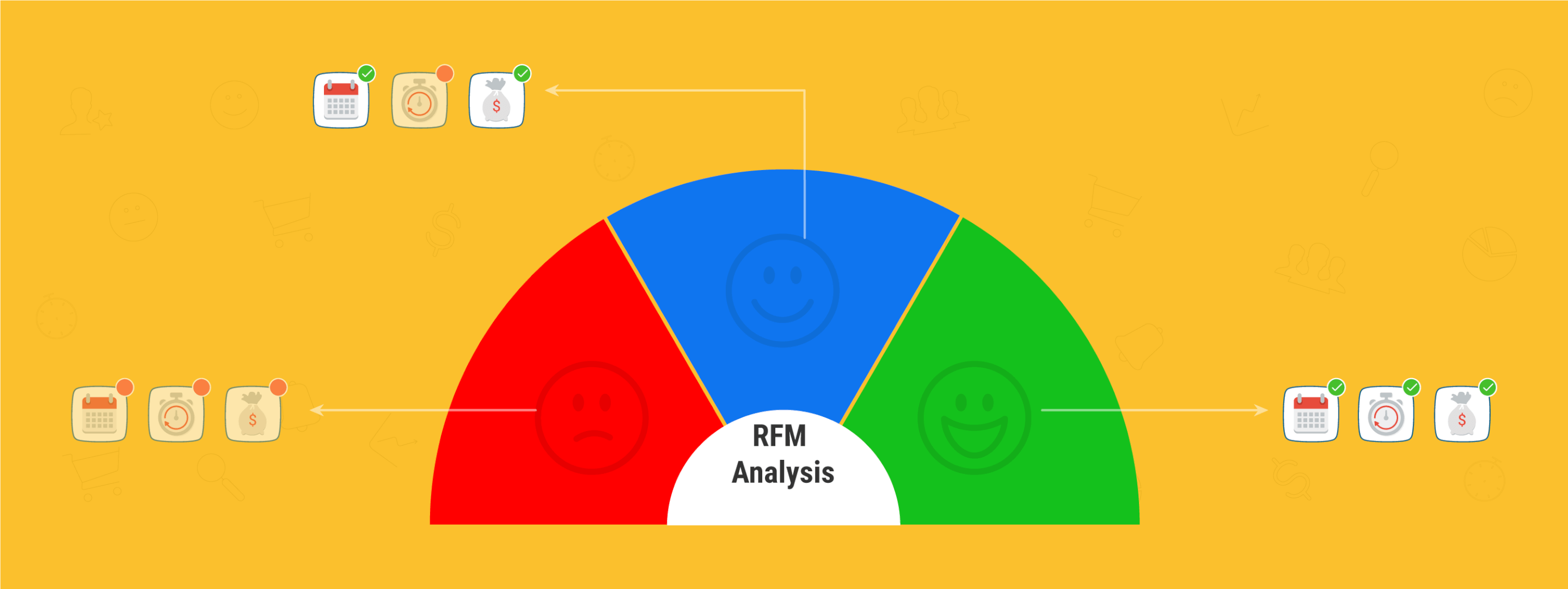Hello!
Business is the core activity to make a living in the modern world. Whether business-to-business, online commerce, or retail, we all aspire to own independent businesses, such as Yalantis.
RFM is an important tool when it comes to marketing. Very few of us are concerned with marketing our businesses. Our marketing approaches are usually very basic. They might fall short on copywriting, or we employ very poor marketing strategies.
What is RFM
 RFM analysis is a marketing model that is entirely based on the consumer's behaviors towards the commodity. It involves segmentation. This is dividing your customers based on their interactions with your product or service.
RFM analysis is a marketing model that is entirely based on the consumer's behaviors towards the commodity. It involves segmentation. This is dividing your customers based on their interactions with your product or service.
Their interaction considers different parameters, this is how recently, often, and the quantity a customer bought (Recency, Frequency, and Monetary).
The RFM analysis allows you to be more precise with your predictions. With the information, segmentation can be more effective and bear fruits.
The right respondents are targeted, and valid emails are sent to them. The same is applied to the non-respondents. Your marketing campaigns would be more direct, and the engagements would gradually increase.
With the RFM analysis, a lot of questions are tackled. Many businesses aim to provide a suitable explanation for:
• Which category of customers is on the verge of getting lost?
• Who has the potential to be converted to a more profitable customer?
• Which category of customers is more likely to engage with their promotions and offers?
• Who are the most active customers?
• Which category of customers needs the most attention?
• Which category of customers interact with your products more frequently?
Benefits of Conducting RFM Analysis
Identifying a customer becomes easy
You can realize higher profits if you are able to identify your most valuable customers. It will be easier for you to turn them into target market segments. These are the most recent and the customers who frequently purchase the products.
 Studying your customers’ behavioral aspects would be more crucial. The business should be thorough with the analysis to identify valuable clients. This is, however, controversial since there is a very thin line between that and intruding on their privacy.
Studying your customers’ behavioral aspects would be more crucial. The business should be thorough with the analysis to identify valuable clients. This is, however, controversial since there is a very thin line between that and intruding on their privacy.
When establishing a marketing campaign, you should initially pick up a target segment.
Having a specific segment in mind, you will be able to easily pick promotional material that resonates with the intended audience. For you to implement this, RFM will be a very important tool.
Your business can reward loyal customers. It can be in many different forms. This can range from loyalty programs to good discounts. You can also line up good promotions and offers which will keep them coming.
Sending them custom messages can be another alternative. You can be able to generate higher conversions from this strategy. It will also increase the chances of success for the marketing campaigns.
Recognizing your loyal customers has long-term benefits. Your business will have even more outstanding sales. It also contributes to longer customer retention. This goes to show the importance of recognizing your best customers.
Create Spot-on Activation Strategies for Your Customer Segments
Segmentation is a vital process in RFM analysis. Businesses can be able to group their consumers into essential categories. These clusters are flexible and can change from one business to the other.
 They can range from:
They can range from:
1. Slowly lost customers: These are the customers that were once frequent buyers and were lucrative with their spendings. These customers haven't visited the business platform recently. Sending them relevant surveys to find what went wrong would be the better step to take. This helps to avoid losing them to a competitor.
2. Risk customers: This category has customers who often buy products and spend big amounts. However, they have not made any purchases recently. It would be best if you involved them more by sending reactivation campaigns. Such measures would encourage them to make another purchase.
3. Newbies: These are the new customers that you have acquired. They are not frequent shoppers since they are just getting started. It is important to establish relationships with such customers to keep them coming. You can offer onboard support and special offers. This would spike their interest and increase their visits.
4. Loyalists: These are your recent customers who spend a decent amount of money on your business. They are not as frequent but make sure they spend a good amount. For such customers, you can always email-related products to always keep them interested. You can also use loyalty programs in the hope of elevating them from potential loyalists to champions.
5. Champions: These are your best customers. They meet all the factors in the RFM analysis. They are the frequent buyers and the most recent. These same customers spend when interacting with your products. You should reward these champion customers properly. They help a long way in promoting the brand of the company.
These segments can help in deciding the strategy to take with each segment. These are mainly the marketing and sales strategies. The process is complemented with the collection of accurate data.
Combine RFM With Other Reports
The main advantage of RFM analysis is getting detailed information on your customers. Combining the findings with other reports complements the information extracted. This allows you to get even better insights into the client's buying behaviors.
 Other reports show your customers’ activities on other platforms. This helps your business as you can come up with more personalized messages to a target customer.
Other reports show your customers’ activities on other platforms. This helps your business as you can come up with more personalized messages to a target customer.
This helps when identifying the different clusters that your customers fall in. It will in turn help the business know those that are more likely to respond to your promotions. It is also useful in future personalization services.
As pointed out, the model is based on three quantitative factors. The measures are broadly expanded below:
User Segmentation by Monetary Value
 This measure focuses on how much the customer is willing to spend on your commodity. It stems from the lucrativeness of the expenditures of the customers.
This measure focuses on how much the customer is willing to spend on your commodity. It stems from the lucrativeness of the expenditures of the customers.
The business would be inclined to persuade those customers who spend more in the business. This measure is both beneficial and harmful to the business.
It would be a better marketing strategy in terms of return on investments. Those who spend more are encouraged to visit more. On the other side, it pushes away the customers who are not as lucrative but consistent with their purchases.
User Segmentation by the Age of Purchase
Customers who most recently interacted with the company are more likely to make another purchase. This is because they have the organization in mind and can reach out for another commodity.
 Customers who have not been active are on the other end of the spectrum. They are less likely to think about the brand.
Customers who have not been active are on the other end of the spectrum. They are less likely to think about the brand.
With such information, your company is better positioned to know who to alert of a new product. They are more likely to engage in future transactions. You can remind them to revisit the business and check out the new deals and updates.
For the lapsed customers, you can enforce other marketing strategies to rekindle their interest. This could be an incentive to make a purchase.
User Segmentation by Frequency
 The frequency of a customer considers other factors. This can be:
The frequency of a customer considers other factors. This can be:
• If there is a need for replacement of the product (Or to replenish)
• Type of commodity
• The price of these products or services
If you can predict the purchase cycle of your customers, your marketing strategies would be more efficient. In unison, all the RFM factors can be an important tool to predict the likelihood of the customer to do business again with the firm.
Making a final judgment is quite difficult. This is especially the case if you base it on one parameter. It would give you an inaccurate report of your customer base and their lifetime value.
RFM analysis is, however, not restricted to email marketing. It is a crucial segmentation tool. The analysis can be used for even greater purposes. When used the right way, you can make actionable strategies with the data collected.
Also read:
- Americans Absolutely Detest AI That Makes Decisions for Them
- 50 Most Essential Marketing Skills You Need To Be Successful
- Latest Technologies and Innovation for Future
Integrate RFM Analysis in Email Marketing
 RFM analysis is a very resourceful tool if used in the right way. You can make actionable strategies around the data that you have collected. It can be a very powerful segmentation tool if you understand how to utilize the data it delivers.
RFM analysis is a very resourceful tool if used in the right way. You can make actionable strategies around the data that you have collected. It can be a very powerful segmentation tool if you understand how to utilize the data it delivers.
However, RFM only uses historical customer data and may not be able to predict future customer activity. Predictive methods can identify future customer behavior that may not be identified by RFM analysis.
The strategies can be both offensive and defensive. The offensive ones include treating your customers who spend more as VIPs. This is to increase the number of orders and help with customer retention.
Defensive strategies are like identifying dormant customers. It can be to pique their interest and see if they would engage with the product again. You can then employ targeted offers and promotions.
Thank you!
Subscribe to our newsletter! Join us on social networks!
See you!






